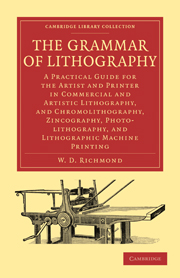 The Grammar of Lithography
The Grammar of Lithography Book contents
- Frontmatter
- Contents
- EDITOR'S INTRODUCTION
- PART I DRAWING, TRANSFERRING AND PRINTING
- CHAPTER I Introductory
- CHAPTER II Mechanical and Chemical Principles of some of the Lithographic Materials used in Printing
- CHAPTER III Instruments, Tools, and Appliances used in Drawing and Writing
- CHAPTER IV Instruments, Tools, and Apparatus used in Printing
- CHAPTER V Accessories to the Lithographic Printing-press
- CHAPTER VI Grinding and Polishing Stones
- CHAPTER VII Lithography on Paper or Transfer Lithography
- CHAPTER VIII Ink Writing and Drawing on Stone
- CHAPTER IX Chalk Drawing on Stone
- CHAPTER X Etching Chalk Drawings on Stone
- CHAPTER XI Taking Impressions for Transferring
- CHAPTER XII Transferring
- CHAPTER XIII Proving and Printing
- CHAPTER XIV Printing (continued)
- CHAPTER XV Printing (continued)
- CHAPTER XVI Miscellaneous Processe
- CHAPTER XVII Miscellaneous Processes (continued)
- CHAPTER XVIII Engraving on Stone
- CHAPTER XIX Zincography
- CHAPTER XX Chromo-lithography
- CHAPTER XXI Chromo-lithography (continued)
- CHAPTER XXII Chromo-lithography (continued)
- CHAPTER XXIII Chromo-lithography (continued)
- CHAPTER XXIV Photo-lithography
- APPENDIX.—Recipes
- PART II LITHOGRAPHIC MACHINE-PRINTING
- BIBLIOGRAPHY OF LITHOGRAPHY
- INDEX
CHAPTER IX - Chalk Drawing on Stone
Published online by Cambridge University Press: 05 July 2011
- Frontmatter
- Contents
- EDITOR'S INTRODUCTION
- PART I DRAWING, TRANSFERRING AND PRINTING
- CHAPTER I Introductory
- CHAPTER II Mechanical and Chemical Principles of some of the Lithographic Materials used in Printing
- CHAPTER III Instruments, Tools, and Appliances used in Drawing and Writing
- CHAPTER IV Instruments, Tools, and Apparatus used in Printing
- CHAPTER V Accessories to the Lithographic Printing-press
- CHAPTER VI Grinding and Polishing Stones
- CHAPTER VII Lithography on Paper or Transfer Lithography
- CHAPTER VIII Ink Writing and Drawing on Stone
- CHAPTER IX Chalk Drawing on Stone
- CHAPTER X Etching Chalk Drawings on Stone
- CHAPTER XI Taking Impressions for Transferring
- CHAPTER XII Transferring
- CHAPTER XIII Proving and Printing
- CHAPTER XIV Printing (continued)
- CHAPTER XV Printing (continued)
- CHAPTER XVI Miscellaneous Processe
- CHAPTER XVII Miscellaneous Processes (continued)
- CHAPTER XVIII Engraving on Stone
- CHAPTER XIX Zincography
- CHAPTER XX Chromo-lithography
- CHAPTER XXI Chromo-lithography (continued)
- CHAPTER XXII Chromo-lithography (continued)
- CHAPTER XXIII Chromo-lithography (continued)
- CHAPTER XXIV Photo-lithography
- APPENDIX.—Recipes
- PART II LITHOGRAPHIC MACHINE-PRINTING
- BIBLIOGRAPHY OF LITHOGRAPHY
- INDEX
Summary
No part of our subject at all equals in artistic importance that upon which we are about to enter, viz. that of drawing in crayon or chalk upon the stone. By it an accomplished artist is enabled to reproduce the works of our best painters in a manner but little inferior to that of the best engravings; and we feel convinced that if the same study and talent were bestowed upon lithography as is necessary for engraving, our favourite art would be found quite equal to the successful reproduction of all classes of pictures.
88.The drawing on stone treated of in the last chapter refers more especially to that kind of lithography usually denominated “ink” or “line work,” and executed on polished stones; while that upon which it is proposed now to enter is called chalk or crayon drawing, and derives its name from similar work upon paper, which it may be said to excel.
Instead of being polished, the surface of the stone is, for this kind of work, broken up into minute points, technically called “a grain,” which, when drawn upon, receives the lithographic chalk in proportion to the pressure employed. This grain is most essential, not only in giving clearness of texture and transparency in the impressions, but, by reason of its hardness and sharpness, acting as a rasp to take off a sufficient quantity of crayon to give blackness and body to each dot.
- Type
- Chapter
- Information
- The Grammar of LithographyA Practical Guide for the Artist and Printer in Commercial and Artistic Lithography, and Chromolithography, Zincography, Photo-lithography, and Lithographic Machine Printing, pp. 60 - 69Publisher: Cambridge University PressPrint publication year: 2010First published in: 1878


